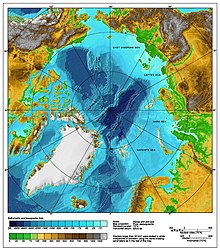
Back Аҩадатәи аокеан ҵааршә Abkhazian Laôt Arktik ACE Щтыгъэ Океан ADY Arktiese Oseaan Afrikaans Arktischer Ozean ALS አርክቲክ ውቅያኖስ Amharic Oceano Glacial Arctico AN Īshæf ANG उत्तरध्रुवीय महासागर ANP المحيط المتجمد الشمالي Arabic
| Earth's oceans (World Ocean) |
|---|

The Arctic Ocean is the ocean around the North Pole. The most northern parts of Eurasia and North America are around the Arctic Ocean. Thick pack ice and snow cover almost all of this ocean in winter, and most of it in summer. An icebreaker or a nuclear-powered submarine can use the Northwest Passage through the Arctic Ocean to go between the Pacific and Atlantic oceans.
The ocean's area is about 14.056 million km2, which is the smallest of the world's 5 oceans, and it has 45,389 kilometres (28,203 miles) of coastline. The central surface covered by ice about 3 metres (9.8 feet) thick. The biology there is quite special. Endangered species there include walruses, whales and polar bears. Year by year the Arctic Ocean is becoming less icy, as a result of global warming.
The average depth of the Arctic Ocean is 1,038 metres (3,406 feet).[1] The deepest point is in the Eurasian Basin, at 5,450 m (17,881 ft).
- ↑ "The Mariana Trench - Oceanography". www.marianatrench.com. 2003-04-04. Archived from the original on 2006-12-07. Retrieved 2006-12-02.
